Abstract
The HGT-1 human gastric cell line is similar to acid secreting parietal cells in that it possesses H2 receptors, histamine sensitive adenyl cyclase, and Cl- channels, which are activated by histamine by a cyclic adenosine monophosphate (cAMP) dependent mechanism. To discover if HGT-1 cells have additional properties found in parietal cells, [3H]omeprazole and patch clamp recording techniques were used to evaluate specific omeprazole binding sites and K+ channels in the plasma membrane. HGT-1 cells exhibited [3H]omeprazole binding in the non-stimulated state, which increased 100% in the presence of 1 mM histamine. High conductance (about 155 pS) K+ channels were active spontaneously in 17% of cell attached or excised inside out patches in non-stimulated subconfluent HGT-1 cells. In inside out patches, channel activity increased fivefold during depolarisation, ion substitution experiments confirmed that the channels were highly selective for K+, and channel activity was almost abolished by removal of Ca2+ or addition of 5 mM Ba2+. In quiescent cell attached patches, 0.1 mM dibutyryl cAMP failed to activate K+ channels. In contrast, 6.7 microM A23187 (a Ca2+ ionophore) increased intracellular Ca2+ concentration from mean (SEM) 14 (3) nM to 248 (30) nM and activated K+ channels in 21% of patches. It is concluded that the plasma membrane of HGT-1 cells possesses (a) specific 3H-omeprazole binding sites, which may reflect the omeprazole sensitive H+,K(+)-ATPase present in gastric parietal cells; and (b) Ca(2+)-activated K+ channels, which may be located in the basolateral membrane of human gastric parietal cells and play a part in acid secretion triggered by Ca(2+)-mediated secretory agonists.
Full text
PDF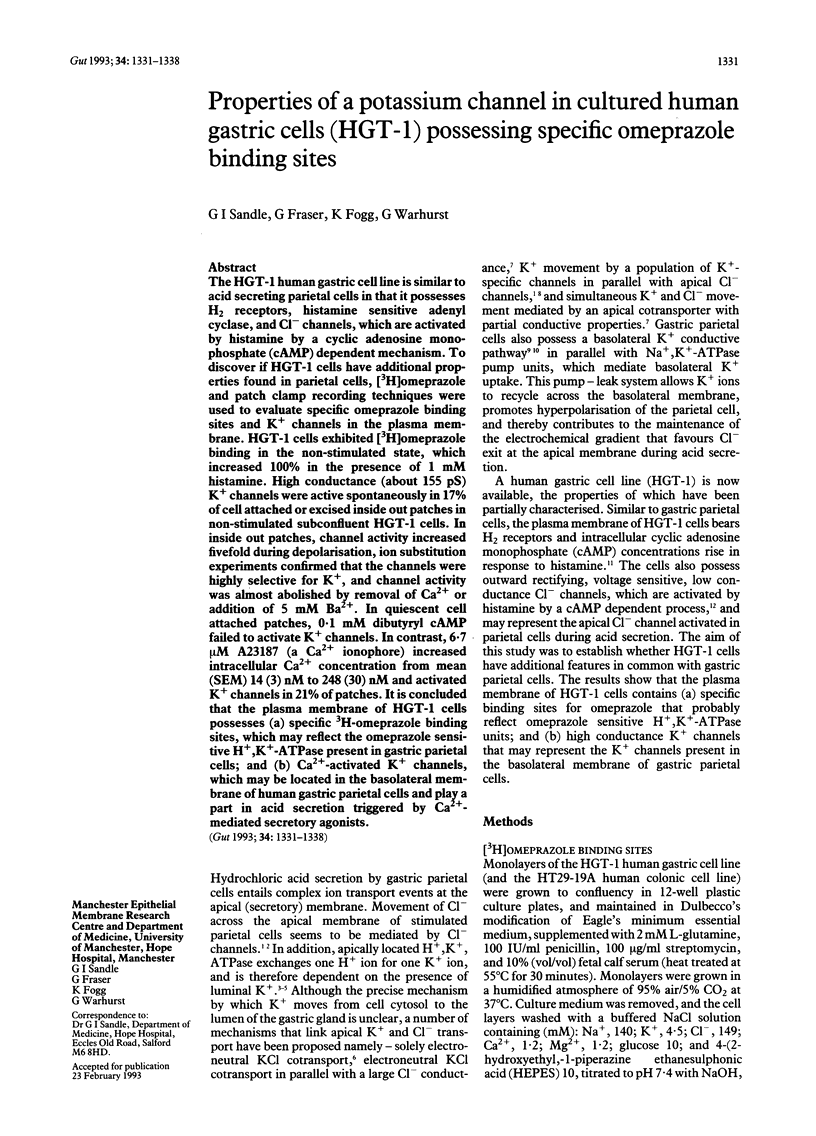
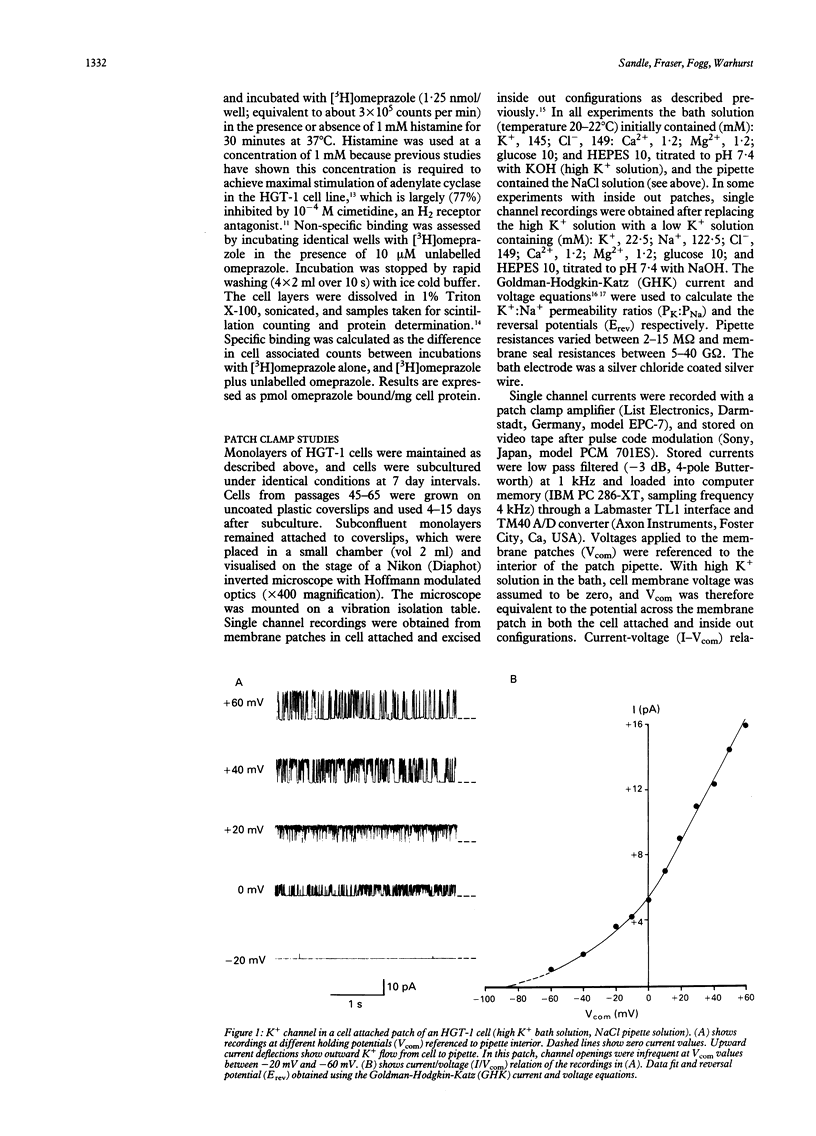
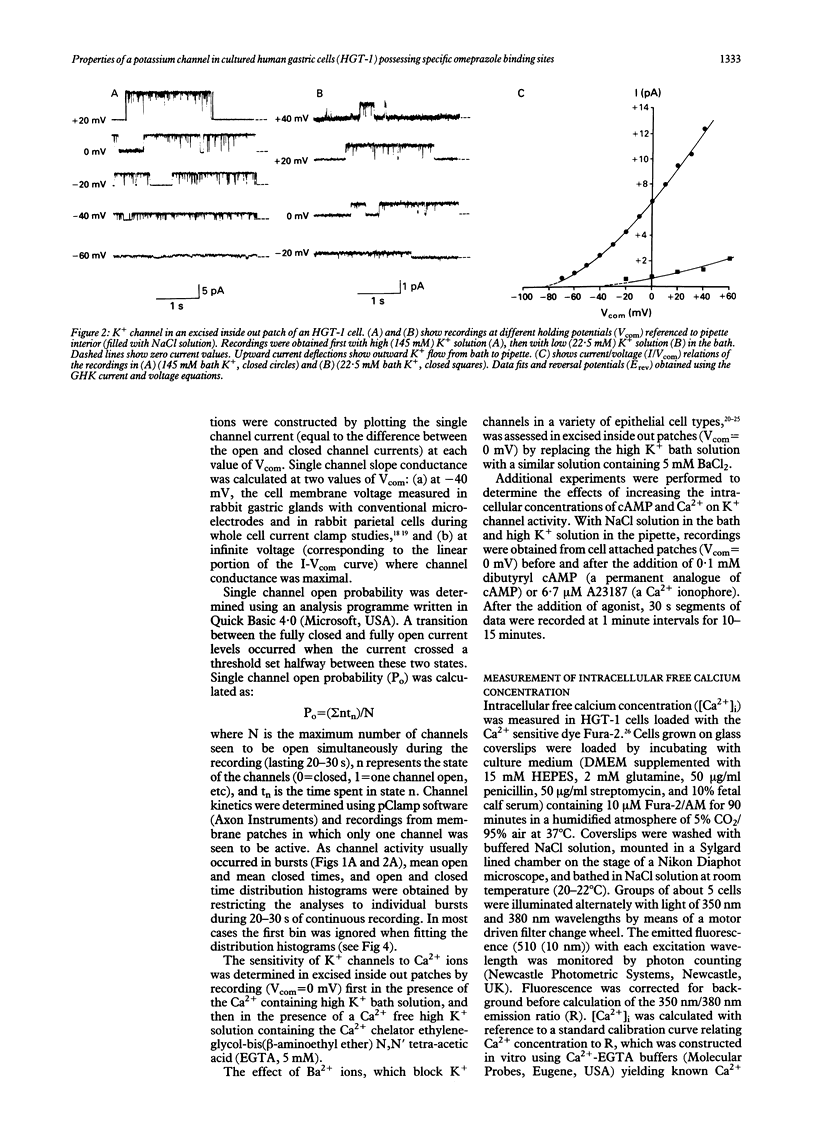
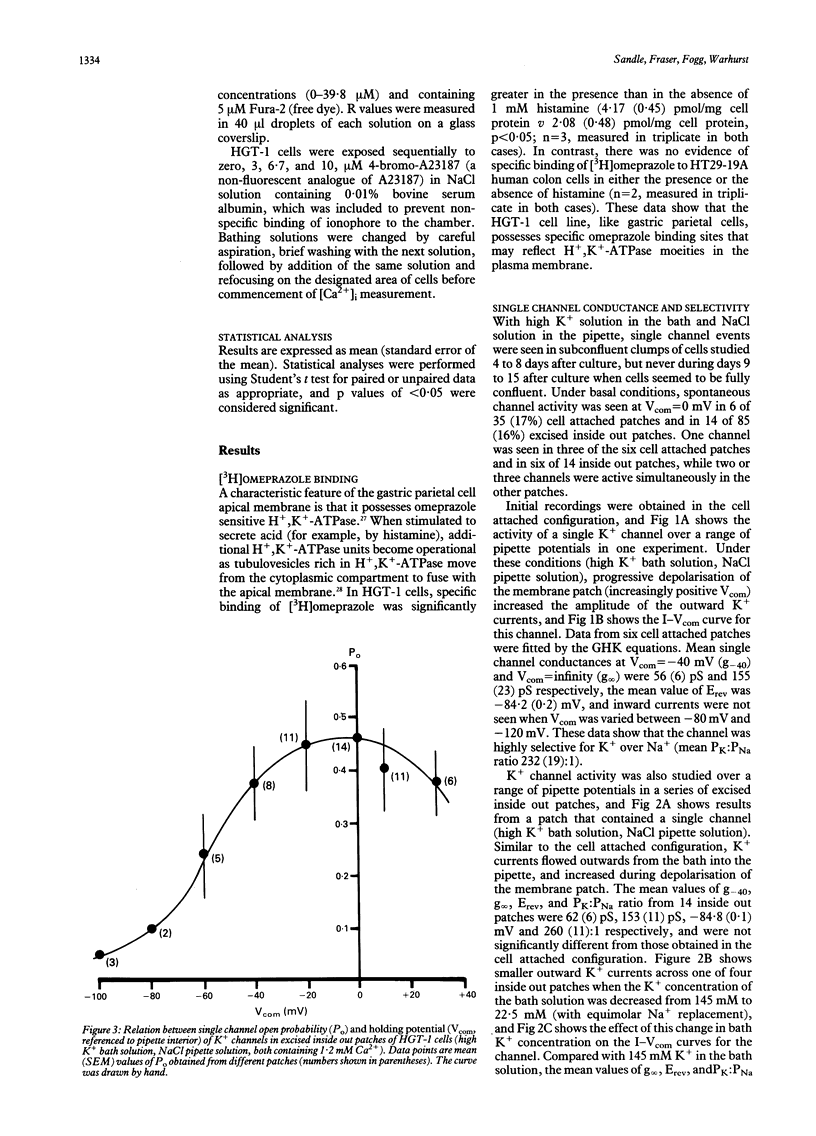
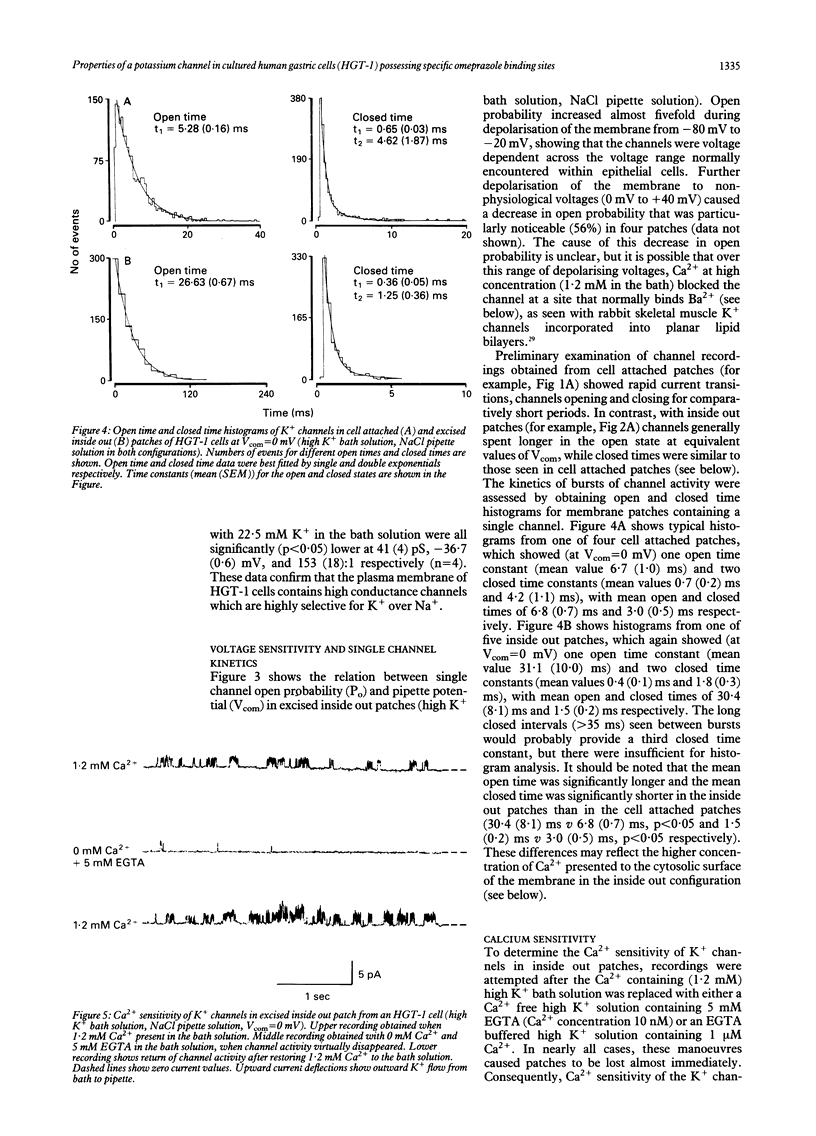
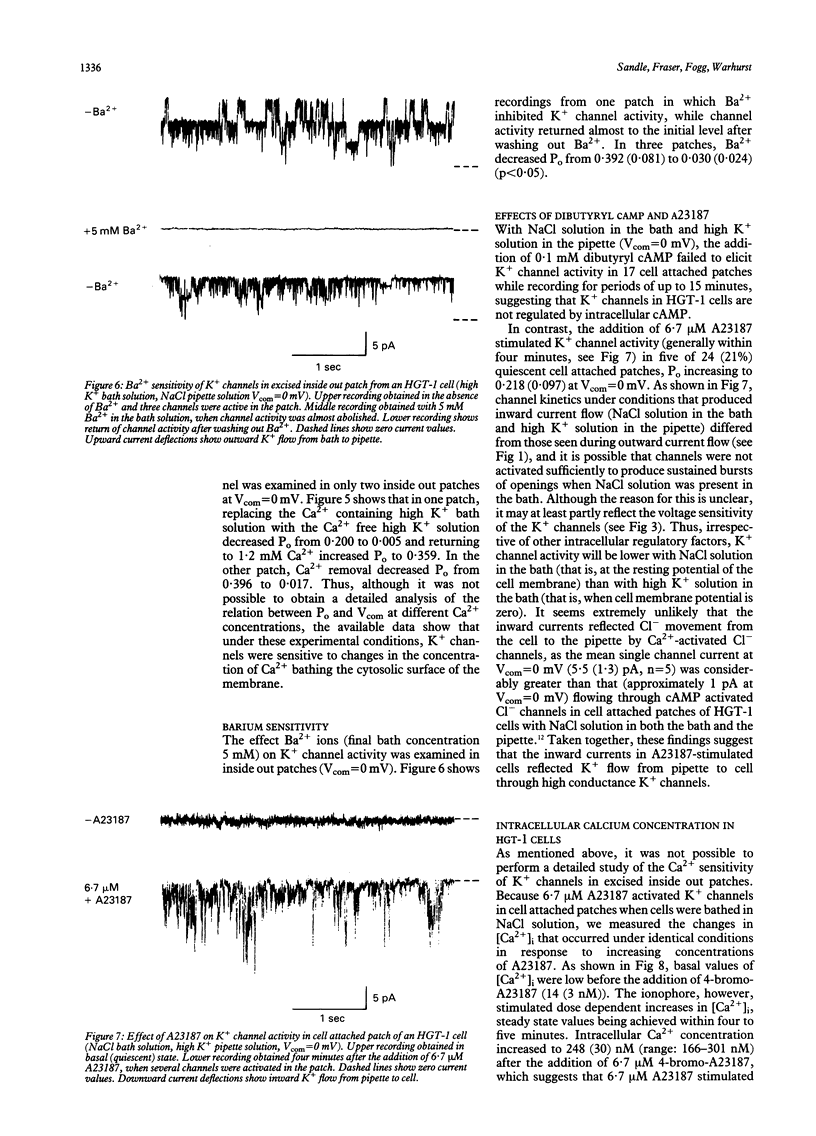
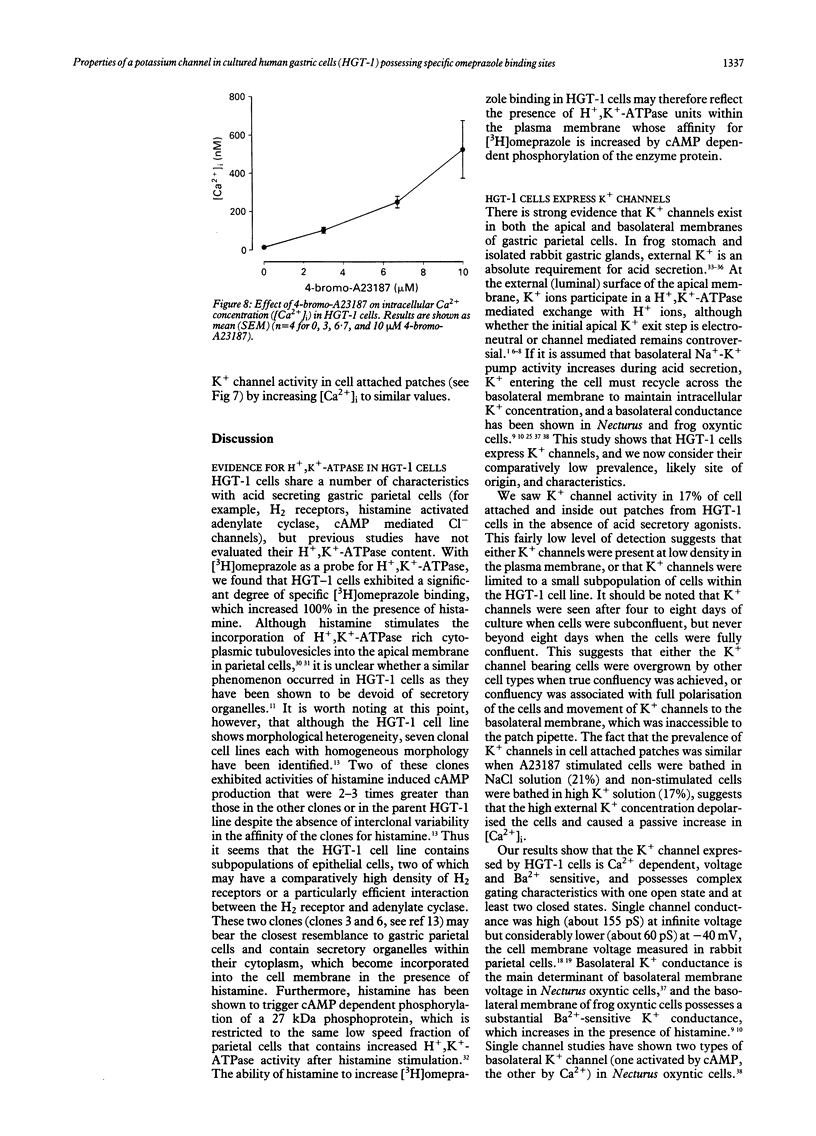
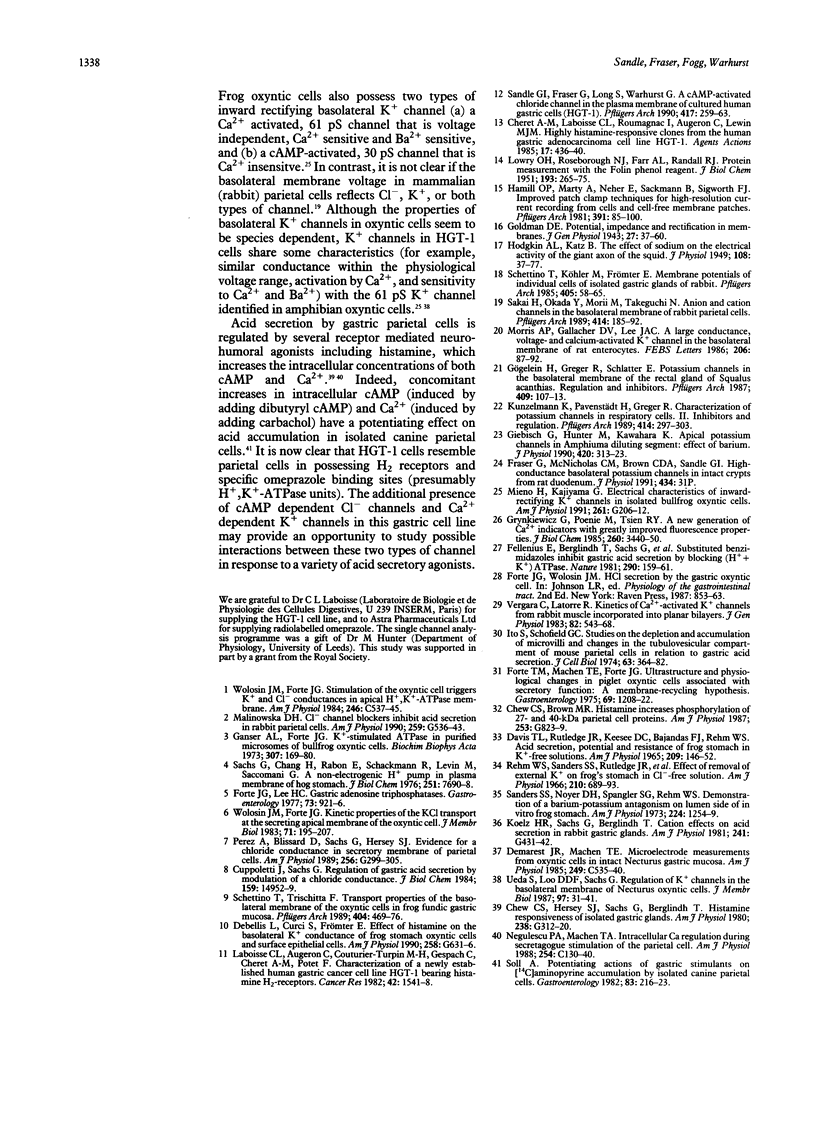
Selected References
These references are in PubMed. This may not be the complete list of references from this article.
- AVIS T. L., RUTLEDGE J. R., KEESEE D. C., BAJANDAS F. J., REHM W. S. ACID SECRETION, POTENTIAL, AND RESISTANCE OF FROG STOMACH IN K+-FREE SOLUTIONS. Am J Physiol. 1965 Jul;209:146–152. doi: 10.1152/ajplegacy.1965.209.1.146. [DOI] [PubMed] [Google Scholar]
- Cheret A. M., Laboisse C. L., Roumagnac I., Augeron C., Lewin M. J. Highly histamine-responsive clones from the human gastric adenocarcinoma cell line HGT-1. Agents Actions. 1986 Mar;17(5-6):436–440. doi: 10.1007/BF01965510. [DOI] [PubMed] [Google Scholar]
- Chew C. S., Brown M. R. Histamine increases phosphorylation of 27- and 40-kDa parietal cell proteins. Am J Physiol. 1987 Dec;253(6 Pt 1):G823–G829. doi: 10.1152/ajpgi.1987.253.6.G823. [DOI] [PubMed] [Google Scholar]
- Chew C. S., Hersey S. J., Sachs G., Berglindh T. Histamine responsiveness of isolated gastric glands. Am J Physiol. 1980 Apr;238(4):G312–G320. doi: 10.1152/ajpgi.1980.238.4.G312. [DOI] [PubMed] [Google Scholar]
- Cuppoletti J., Sachs G. Regulation of gastric acid secretion via modulation of a chloride conductance. J Biol Chem. 1984 Dec 10;259(23):14952–14959. [PubMed] [Google Scholar]
- Debellis L., Curci S., Frömter E. Effect of histamine on the basolateral K+ conductance of frog stomach oxyntic cells and surface epithelial cells. Am J Physiol. 1990 Apr;258(4 Pt 1):G631–G636. doi: 10.1152/ajpgi.1990.258.4.G631. [DOI] [PubMed] [Google Scholar]
- Demarest J. R., Machen T. E. Microelectrode measurements from oxyntic cells in intact Necturus gastric mucosa. Am J Physiol. 1985 Nov;249(5 Pt 1):C535–C540. doi: 10.1152/ajpcell.1985.249.5.C535. [DOI] [PubMed] [Google Scholar]
- Fellenius E., Berglindh T., Sachs G., Olbe L., Elander B., Sjöstrand S. E., Wallmark B. Substituted benzimidazoles inhibit gastric acid secretion by blocking (H+ + K+)ATPase. Nature. 1981 Mar 12;290(5802):159–161. doi: 10.1038/290159a0. [DOI] [PubMed] [Google Scholar]
- Forte J. G., Lee H. C. Gastric adenosine triphosphatases: a review of their possible role in HCl secretion. Gastroenterology. 1977 Oct;73(4 Pt 2):921–926. [PubMed] [Google Scholar]
- Forte T. M., Machen T. E., Forte J. G. Ultrastructural and physiological changes in piglet oxyntic cells during histamine stimulation and metabolic inhibition. Gastroenterology. 1975 Dec;69(6):1208–1222. [PubMed] [Google Scholar]
- Ganser A. L., Forte J. G. K + -stimulated ATPase in purified microsomes of bullfrog oxyntic cells. Biochim Biophys Acta. 1973 Apr 25;307(1):169–180. doi: 10.1016/0005-2736(73)90035-7. [DOI] [PubMed] [Google Scholar]
- Giebisch G., Hunter M., Kawahara K. Apical potassium channels in Amphiuma diluting segment: effect of barium. J Physiol. 1990 Jan;420:313–323. doi: 10.1113/jphysiol.1990.sp017914. [DOI] [PMC free article] [PubMed] [Google Scholar]
- Goldman D. E. POTENTIAL, IMPEDANCE, AND RECTIFICATION IN MEMBRANES. J Gen Physiol. 1943 Sep 20;27(1):37–60. doi: 10.1085/jgp.27.1.37. [DOI] [PMC free article] [PubMed] [Google Scholar]
- Grynkiewicz G., Poenie M., Tsien R. Y. A new generation of Ca2+ indicators with greatly improved fluorescence properties. J Biol Chem. 1985 Mar 25;260(6):3440–3450. [PubMed] [Google Scholar]
- Gögelein H., Greger R., Schlatter E. Potassium channels in the basolateral membrane of the rectal gland of Squalus acanthias. Regulation and inhibitors. Pflugers Arch. 1987 Jun;409(1-2):107–113. doi: 10.1007/BF00584756. [DOI] [PubMed] [Google Scholar]
- HODGKIN A. L., KATZ B. The effect of sodium ions on the electrical activity of giant axon of the squid. J Physiol. 1949 Mar 1;108(1):37–77. doi: 10.1113/jphysiol.1949.sp004310. [DOI] [PMC free article] [PubMed] [Google Scholar]
- Hamill O. P., Marty A., Neher E., Sakmann B., Sigworth F. J. Improved patch-clamp techniques for high-resolution current recording from cells and cell-free membrane patches. Pflugers Arch. 1981 Aug;391(2):85–100. doi: 10.1007/BF00656997. [DOI] [PubMed] [Google Scholar]
- Ito S., Schofield G. C. Studies on the depletion and accumulation of microvilli and changes in the tubulovesicular compartment of mouse parietal cells in relation to gastric acid secretion. J Cell Biol. 1974 Nov;63(2 Pt 1):364–382. doi: 10.1083/jcb.63.2.364. [DOI] [PMC free article] [PubMed] [Google Scholar]
- Koelz H. R., Sachs G., Berglindh T. Cation effects on acid secretion in rabbit gastric glands. Am J Physiol. 1981 Nov;241(5):G431–G442. doi: 10.1152/ajpgi.1981.241.5.G431. [DOI] [PubMed] [Google Scholar]
- Kunzelmann K., Pavenstädt H., Greger R. Characterization of potassium channels in respiratory cells. II. Inhibitors and regulation. Pflugers Arch. 1989 Jul;414(3):297–303. doi: 10.1007/BF00584630. [DOI] [PubMed] [Google Scholar]
- LOWRY O. H., ROSEBROUGH N. J., FARR A. L., RANDALL R. J. Protein measurement with the Folin phenol reagent. J Biol Chem. 1951 Nov;193(1):265–275. [PubMed] [Google Scholar]
- Laboisse C. L., Augeron C., Couturier-Turpin M. H., Gespach C., Cheret A. M., Potet F. Characterization of a newly established human gastric cancer cell line HGT-1 bearing histamine H2-receptors. Cancer Res. 1982 Apr;42(4):1541–1548. [PubMed] [Google Scholar]
- Malinowska D. H. Cl- channel blockers inhibit acid secretion in rabbit parietal cells. Am J Physiol. 1990 Oct;259(4 Pt 1):G536–G543. doi: 10.1152/ajpgi.1990.259.4.G536. [DOI] [PubMed] [Google Scholar]
- Mieno H., Kajiyama G. Electrical characteristics of inward-rectifying K+ channels in isolated bullfrog oxyntic cells. Am J Physiol. 1991 Aug;261(2 Pt 1):G206–G212. doi: 10.1152/ajpgi.1991.261.2.G206. [DOI] [PubMed] [Google Scholar]
- Morris A. P., Gallacher D. V., Lee J. A. A large conductance, voltage- and calcium-activated K+ channel in the basolateral membrane of rat enterocytes. FEBS Lett. 1986 Sep 29;206(1):87–92. doi: 10.1016/0014-5793(86)81346-1. [DOI] [PubMed] [Google Scholar]
- Negulescu P. A., Machen T. E. Intracellular Ca regulation during secretagogue stimulation of the parietal cell. Am J Physiol. 1988 Jan;254(1 Pt 1):C130–C140. doi: 10.1152/ajpcell.1988.254.1.C130. [DOI] [PubMed] [Google Scholar]
- Perez A., Blissard D., Sachs G., Hersey S. J. Evidence for a chloride conductance in secretory membrane of parietal cells. Am J Physiol. 1989 Feb;256(2 Pt 1):G299–G305. doi: 10.1152/ajpgi.1989.256.2.G299. [DOI] [PubMed] [Google Scholar]
- Rehm W. S., Sanders S. S., Rutledge J. R., Davis T. L., Kurfees J. F., Keesee D. C., Bajandas F. J. Effect of removal of external K+ on frog's stomach in Cl-minus-free solutions. Am J Physiol. 1966 Apr;210(4):689–693. doi: 10.1152/ajplegacy.1966.210.4.689. [DOI] [PubMed] [Google Scholar]
- Sachs G., Chang H. H., Rabon E., Schackman R., Lewin M., Saccomani G. A nonelectrogenic H+ pump in plasma membranes of hog stomach. J Biol Chem. 1976 Dec 10;251(23):7690–7698. [PubMed] [Google Scholar]
- Sakai H., Okada Y., Morii M., Takeguchi N. Anion and cation channels in the basolateral membrane of rabbit parietal cells. Pflugers Arch. 1989 Jun;414(2):185–192. doi: 10.1007/BF00580962. [DOI] [PubMed] [Google Scholar]
- Sanders S. S., Noyes D. H., Spangler S. G., Rehm W. S. Demonstration of a barium-potassium antagonism on lumen side of in vitro frog stomach. Am J Physiol. 1973 Jun;224(6):1254–1259. doi: 10.1152/ajplegacy.1973.224.6.1254. [DOI] [PubMed] [Google Scholar]
- Sandle G. I., Fraser G., Long S., Warhurst G. A cAMP-activated chloride channel in the plasma membrane of cultured human gastric cells (HGT-1). Pflugers Arch. 1990 Nov;417(3):259–263. doi: 10.1007/BF00370990. [DOI] [PubMed] [Google Scholar]
- Schettino T., Köhler M., Frömter E. Membrane potentials of individual cells of isolated gastric glands of rabbit. Pflugers Arch. 1985 Sep;405(1):58–65. doi: 10.1007/BF00591098. [DOI] [PubMed] [Google Scholar]
- Schettino T., Trischitta F. Transport properties of the basolateral membrane of the oxyntic cells in frog fundic gastric mucosa. Pflugers Arch. 1989 Aug;414(4):469–476. doi: 10.1007/BF00585059. [DOI] [PubMed] [Google Scholar]
- Soll A. H. Potentiating interactions of gastric stimulants on [14 C] aminopyrine accumulation by isolated canine parietal cells. Gastroenterology. 1982 Jul;83(1 Pt 2):216–223. [PubMed] [Google Scholar]
- Ueda S., Loo D. D., Sachs G. Regulation of K+ channels in the basolateral membrane of Necturus oxyntic cells. J Membr Biol. 1987;97(1):31–41. doi: 10.1007/BF01869612. [DOI] [PubMed] [Google Scholar]
- Vergara C., Latorre R. Kinetics of Ca2+-activated K+ channels from rabbit muscle incorporated into planar bilayers. Evidence for a Ca2+ and Ba2+ blockade. J Gen Physiol. 1983 Oct;82(4):543–568. doi: 10.1085/jgp.82.4.543. [DOI] [PMC free article] [PubMed] [Google Scholar]
- Wolosin J. M., Forte J. G. Kinetic properties of the KCl transport at the secreting apical membrane of the oxyntic cell. J Membr Biol. 1983;71(3):195–207. doi: 10.1007/BF01875461. [DOI] [PubMed] [Google Scholar]
- Wolosin J. M., Forte J. G. Stimulation of oxyntic cell triggers K+ and Cl- conductances in apical H+-K+-ATPase membrane. Am J Physiol. 1984 May;246(5 Pt 1):C537–C545. doi: 10.1152/ajpcell.1984.246.5.C537. [DOI] [PubMed] [Google Scholar]


